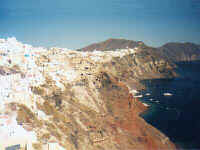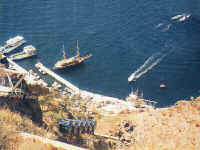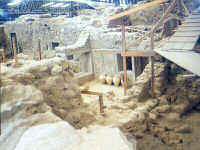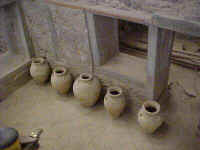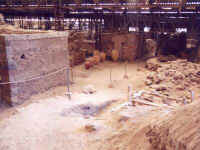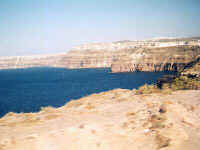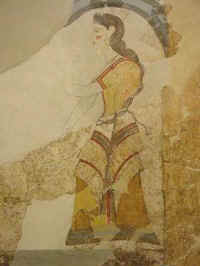|
Page 1 2 3 4 5 6 7 8 9 10 11 12 13 14 15 16 17 18 19 20 21 22 23 Saturday, October 7: We were leaving Mikonos this morning so we had a hurried breakfast at 7:15, were in the taxi at 7:35, and at the airport ten minutes later for our 8:25 flight. Of the five flights we took on Olympic Airways, this was the only one that left on time. Mina's uncle, Toni, met us at the Santorini airport when we arrived at 9:00. He drove us to the Santor Inn in his 1975 Volkswagen beetle. We had room #5, probably the nicest room, with windows facing both south and east. Very much as we had been in Mikonos, we were on a high point at the north end of town. To the south, we had a nice view of the upper part of Fira (the town). To the east, we could see across the flat part of the island all the way to the sea. Walking south over the crest of the hill just 30 yards from the hotel, there was a great view of the caldera and harbor. Santorini (officially Thira) is a unique island. It was a sophisticated outpost of Minoan civilization well before 2000 B.C. It was originally known as Round Island because of its shape. About 1628 B.C., however, it ceased to be round. The island was a volcano that erupted violently, and the whole center of it collapsed into the sea. This may be the origin of the story of Atlantis. The eruption caused severe damage to the Minoan civilization on Crete, 70 miles away, possibly contributing to its decline and eventual collapse. The resulting caldera (almost nine square miles) is the largest in the world, nearly three times larger than that of Krakatoa, the next largest. The volcano has erupted several more times since then, and there have been several earthquakes. Another large section of the original island collapsed in 236 B.C., making the northwestern part a separate island, Tharissia. The remaining main island is more or less crescent-shaped. More recently, two small new islands have appeared in the middle of the caldera. The last catastrophe was an earthquake in 1956 that caused severe damage. After unpacking, we went to explore the center of town, only a five minute walk from the hotel. Fira is perched on the edge of a sheer cliff, 900 feet above the sea. There is a winding stairway down to the harbor. Visitors can ride donkeys up to the town, but there is also a modern cable car (1982) that makes the trip in two minutes. It was mild and sunny, so we decided to catch the bus to Akrotiri to see the archeological excavations while the weather was good. (We would have saved $11 by going Sunday when admission is free.) Akrotiri was a Minoan town on the south side of the island. It was buried by volcanic ash during the big eruption of 1628 B.C. There was a temporary fiberglass roof over the entire excavation to protect it from the weather. This created an almost eerie light. That, combined with the fact this was an active excavation with signs of ongoing work all around us, made this a thrilling experience. Relatively little has been uncovered to date (roughly 5% of the city), but what has been exposed is very impressive. When we came out, it was going to be 20 minutes before the next bus came. We had seen signs pointing to Red Beach not far down the road, so we walked down there. There were a few people in the water or on the beach, but it looked very rocky. (We later learned that the main section of Red Beach, covered with sand and backed by red cliffs, was out of sight around a hill.) As we rode back to Fira on the bus, we had a great view of the caldera from its south end. Later we saw the frescos taken from Akrotiri at the Archealogical Museum. Back in town about 2:00, we bought a sandwich, a spinach/cheese pastry, and drinks, and ate sitting on the wall overlooking the caldera. Then we went back to our room to rest for a couple of hours. By the time the sun went down, it was cool and windy again. We went to the Dominican convent at 6:00 p.m. to hear the sisters of the closed order sing vespers. Their voices, all a capela, were beautiful. St. John's Cathedral was only a few steps away, and we went there for 7:00 Mass. Santorini has had a large Catholic population since the late 15th Century when Catholics began to settle the almost abandoned island. Between pirate attacks and another horrible eruption of the volcano in 1452, the population had fallen to less than 300. We had dinner at the Dionysius, then explored a little. We bought some fruit at one small shop, and a bottle of red wine at another. We intended to have some of the wine back at the hotel. When we arrived just after 9:00, however, there was a note on the door from Toni saying Larry had called. We went upstairs to Toni's, and he called Larry. Jane's brother, Tom, had called Larry saying that Grandma Eberhardt had been hospitalized and was now in a nursing home. We tried to call Tom, then Grandpa, but there was no answer. Jane was very upset. We didn't drink any of the wine. Page 1 2 3 4 5 6 7 8 9 10 11 12 13 14 15 16 17 18 19 20 21 22 23 |

